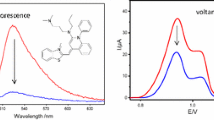Abstract
Marked fluorescence in cytoplasm, nucleus, and nucleolus was observed in HeLa cells after incubation with each of several fluorescein isothiocyanate-labeled peptides (epithalon, Ala-Glu-Asp-Gly; pinealon, Glu-Asp-Arg; testagen, Lys-Glu-Asp-Gly). This means that short biologically active peptides are able to penetrate into an animal cell and its nucleus and, in principle they may interact with various components of cytoplasm and nucleus including DNA and RNA. It was established that various initial (intact) peptides differently affect the fluorescence of the 5,6-carboxyfluorescein-labeled deoxyribooligonucleotides and DNA-ethidium bromide complexes. The Stern-Volmer constants characterizing the degree of fluorescence quenching of various single- and double-stranded fluorescence-labeled deoxyribooligonucleotides with short peptides used were different depending on the peptide primary structures. This indicates the specific interaction between short biologically active peptides and nucleic acid structures. On binding to them, the peptides discriminate between different nucleotide sequences and recognize even their cytosine methylation status. Judging from corresponding constants of the fluorescence quenching, the epithalon, pinealon, and bronchogen (Ala-Glu-Asp-Leu) bind preferentially with deoxyribooligonucleotides containing CNG sequence (CNG sites are targets for cytosine DNA methylation in eukaryotes). Epithalon, testagen, and pinealon seem to preferentially bind with CAG- but bronchogen with CTG-containing sequences. The site-specific interactions of peptides with DNA can control epigenetically the cell genetic functions, and they seem to play an important role in regulation of gene activity even at the earliest stages of life origin and in evolution.
Similar content being viewed by others
Abbreviations
- DAPI:
-
4′,6-diamidino-2-phenylindole
- DNA-EB:
-
DNA-ethidium bromide complex
- FAM:
-
5,6-carboxyfluorescein
- FITC:
-
fluorescein isothiocyanate
References
Khavinson, V. Kh., and Malinin, V. V. (2005) Gerontological Aspects of Genome Peptide Regulation, Karger AG, Basel.
Guryanov, C. A., Kirilina, E. A., Khaidukov, S. V., Suvorov, N. I., Molotkovskaya, I. M., and Mikhailova, A. A. (2006) Bioorg. Khim., 32, 574–578.
Kao, K. K. L., Huang, J. C. T., Yang, Chi-K., et al. (2010) Bioorg. Med. Chem., 18, 366–376.
Khavinson, V. Kh., Fedoreyeva, L. I., and Vanyushin, B. F. (2011) Dokl. Ros. Akad. Nauk, 437, 124–127.
Grokhovsky, S. L., Nikolaev, V. A., Gottikh, B. P., and Zhuze, A. L. (2002) Bioorg. Khim., 28, 502–517.
Laigle, A., Chinsky, L., and Turpin, P. Y. (1982) Nucleic Acids Res., 10, 1707–1720.
Reddy, P. R., and Manjula, P. (2009) Chem. Biodiversity, 6, 71–78.
Lakowicz, J. R., and Weber, G. (1973) Biochemistry, 12, 4161–4170.
Favicchio, R., Dragan, A. I., Kneale, G. G., and Read, C. M. (2009) Methods Mol. Biol. DNA-Protein Interact., 543, 589–611.
Kyte, J., and Doolittle, R. F. (1982) J. Mol. Biol., 157, 105–132.
Vanyushin, B. F., and Ashapkin, V. V. (2009) DNA Methylation in Plants, Nova Biomedical Books, Nova Science Publishers, New York.
Fedoreyeva, L. I., and Vanyushin, B. F. (2011) Biochemistry (Moscow), 76, 651–657.
Vanyushin, B. F., Tkacheva, S. G., and Belozersky, A. N. (1970) Nature, 225, 948–949.
Romanov, G. A., and Vanyushin, B. F. (1981) Biochim. Biophys. Acta, 653, 204–218.
Ranjit, D. K., Rideout, M. C., Nefzi, A., Ostresh, J. M., Pinilla, C., and Segall, A. M. (2010) Bioorg. Med. Chem. Lett., 20, 4531–4534.
Author information
Authors and Affiliations
Corresponding author
Additional information
Published in Russian in Biokhimiya, 2011, Vol. 76, No. 11, pp. 1505–1516.
Originally published in Biochemistry (Moscow) On-Line Papers in Press, as Manuscript BM11-126, September 11, 2011.
Rights and permissions
About this article
Cite this article
Fedoreyeva, L.I., Kireev, I.I., Khavinson, V.K. et al. Penetration of short fluorescence-labeled peptides into the nucleus in HeLa cells and in vitro specific interaction of the peptides with deoxyribooligonucleotides and DNA. Biochemistry Moscow 76, 1210–1219 (2011). https://doi.org/10.1134/S0006297911110022
Received:
Revised:
Published:
Issue Date:
DOI: https://doi.org/10.1134/S0006297911110022




